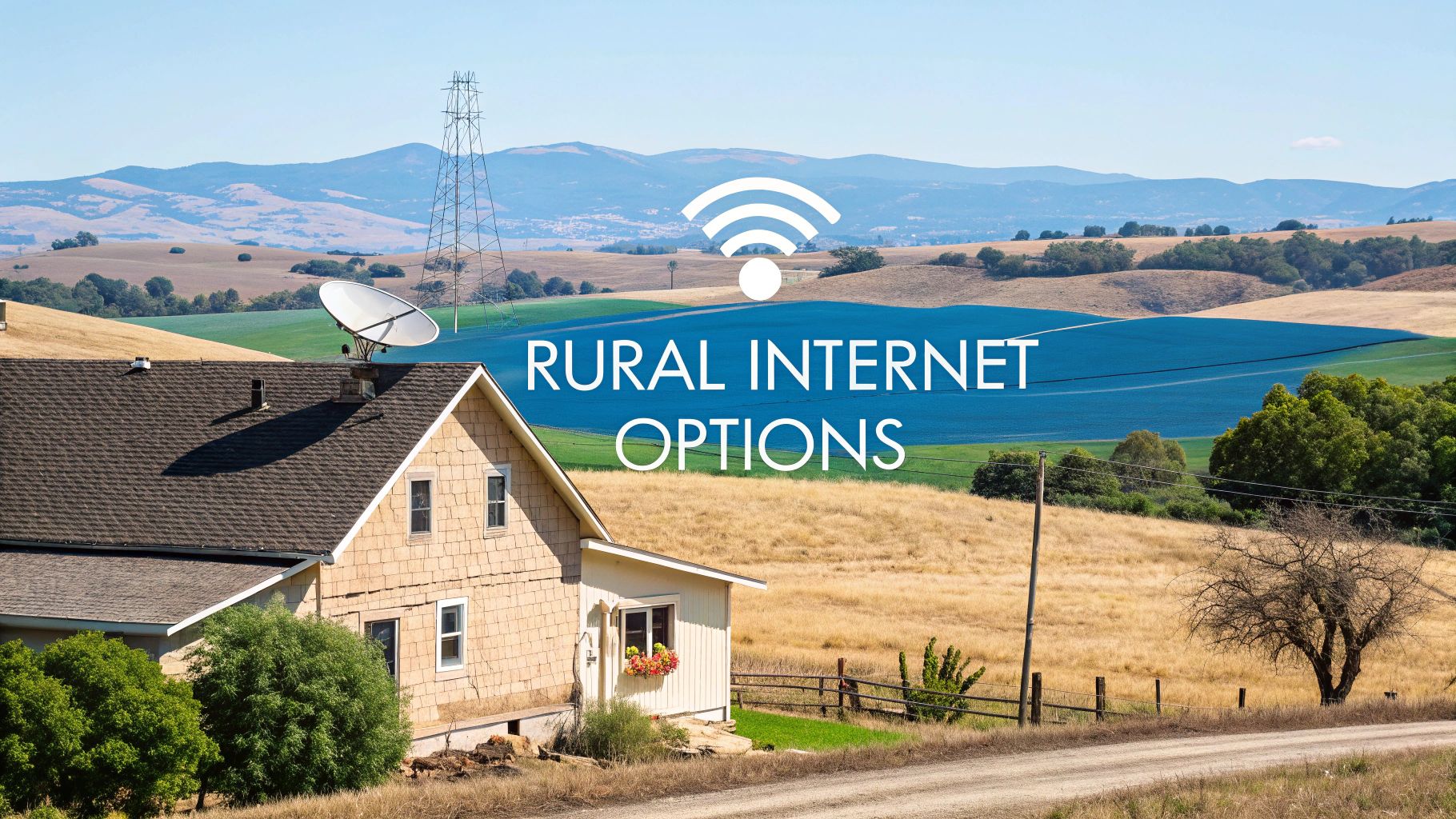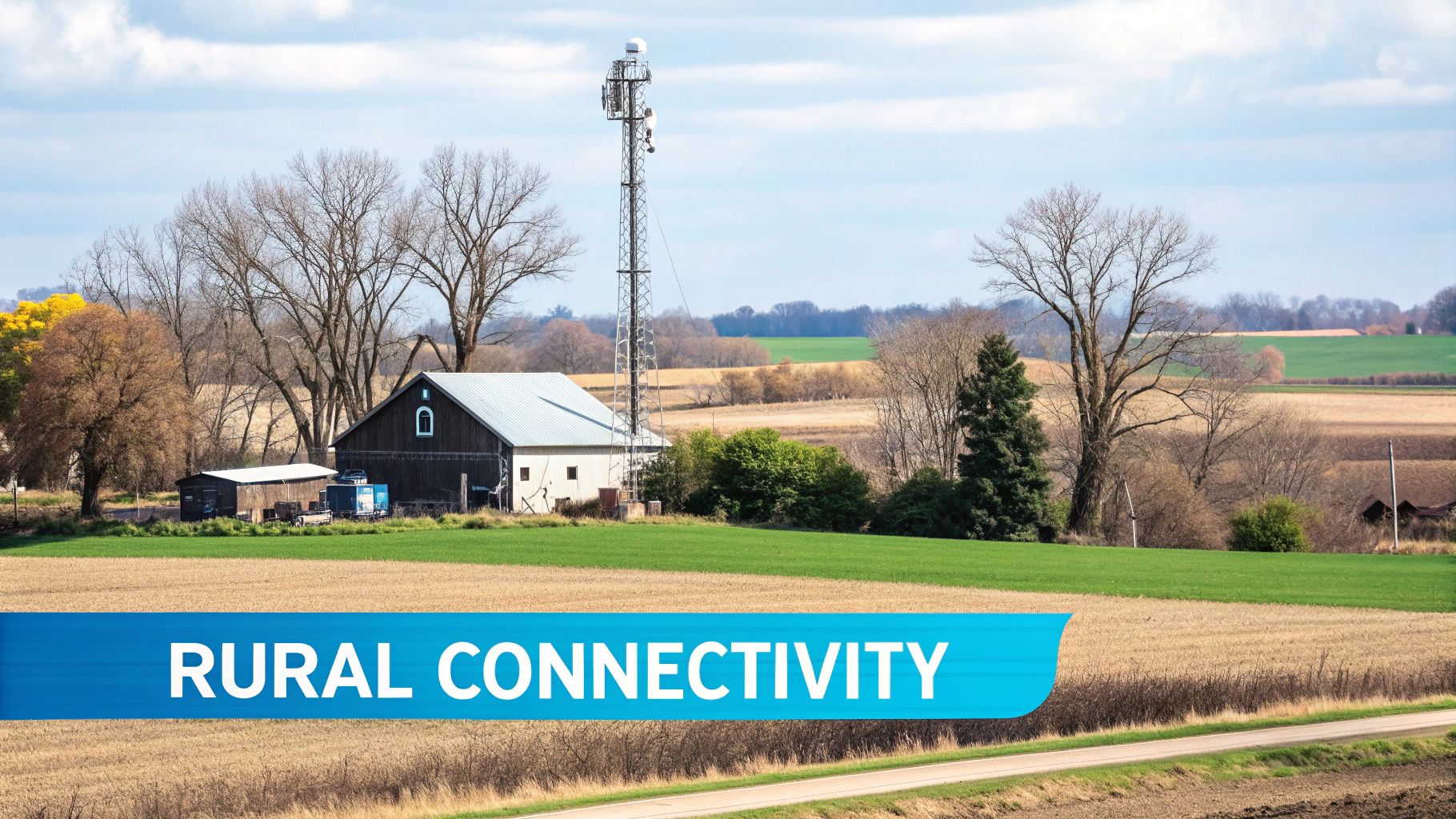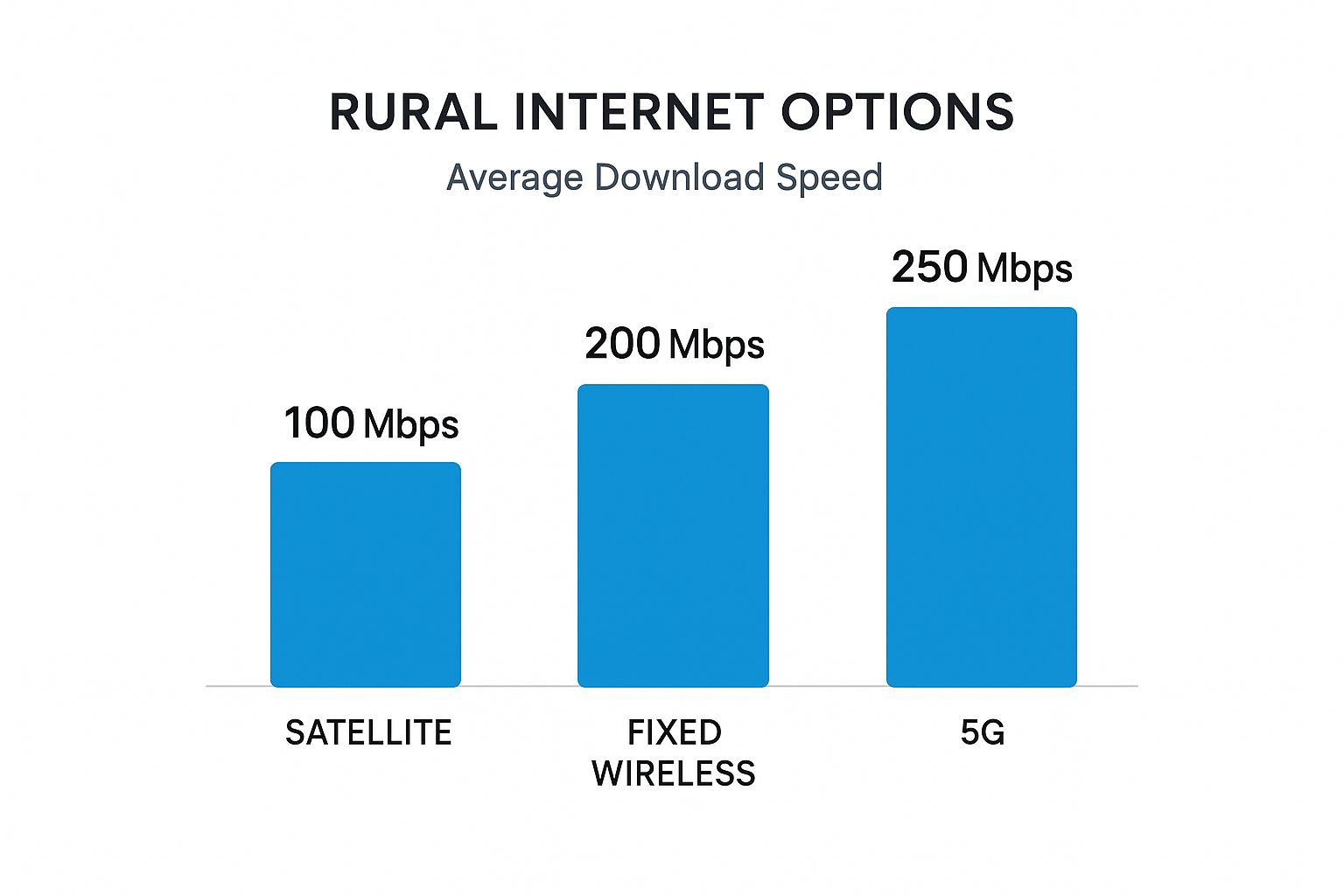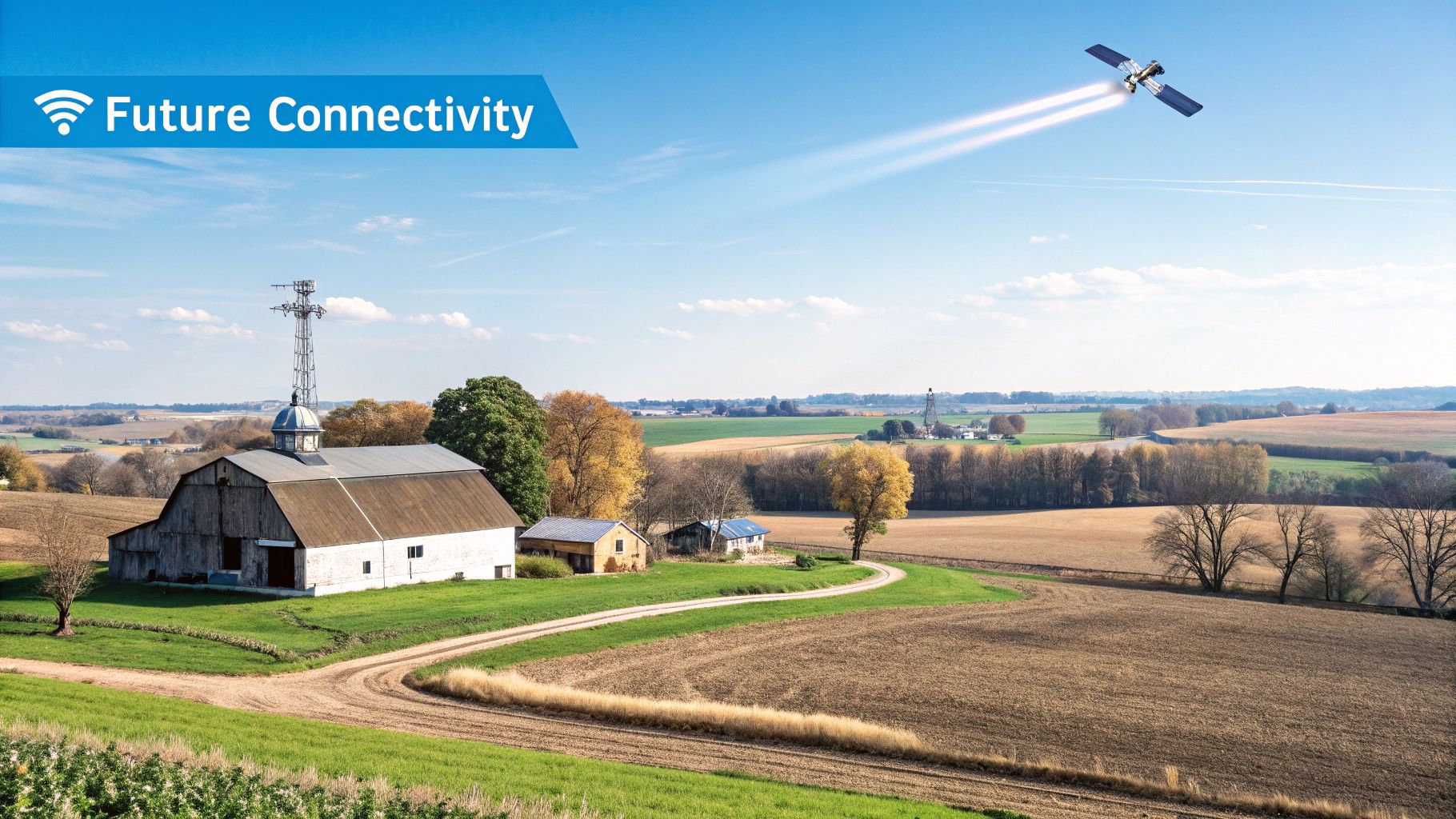

· By James
Finding High Speed Rural Internet Options That Work
Trying to find good, reliable high-speed rural internet can feel like an impossible task, but technology is finally catching up. For most people living out in the country, the best options boil down to three main choices: 5G home internet, satellite services, and fixed wireless access. Each one has its own set of pros and cons when it comes to speed, cost, and just plain availability, depending on where you've put down roots.
Solving the Rural Connectivity Challenge

Living outside the city shouldn't mean being stuck in the digital dark ages. But for too many, the reality is a frustrating hunt for an internet service that can handle remote work, stream a movie on a Friday night, or just keep you connected to family. This guide is here to help you cut through the sales pitches and confusing tech talk.
We’re going to lay out a straightforward, real-world comparison of the leading technologies out there today. The idea is to give you a clear way to pick a solution that actually fits your life—whether you're a professional who can't afford a dropped video call or a family that just wants to watch Netflix without the dreaded buffering wheel.
Why Is Rural Internet So Limited?
The biggest hurdle has always been infrastructure. Traditional high-speed internet, like fiber optic and cable, relies on laying physical lines. That gets incredibly expensive when you have to cover long distances with fewer customers per mile, creating a massive "digital divide."
This isn't just an inconvenience; it has real economic effects. In the United States, for example, only about 61.9% of rural households have broadband access, a stark contrast to the 77.6% in urban areas. This gap is a constant reminder of why we need solid alternatives for rural high-speed internet.
The core issue isn't a lack of technology, but a lack of cost-effective ways to deliver that technology to remote locations. This is precisely where wireless solutions like 5G, fixed wireless, and next-generation satellite are making the biggest impact.
To make the right choice, you have to understand how these technologies really differ. We’ll compare them based on what actually matters: speed, reliability, and what it’s going to cost you each month. You can learn more about how we're bridging the digital divide in our comprehensive guide.
Here's a quick look at what we'll be comparing:
| Technology | Primary Delivery Method | Best For... |
|---|---|---|
| 5G Home Internet | Cellular Network Signals | High-speed, low-latency needs in areas with 5G coverage |
| Satellite Internet | Dish receiving signals from space | Universal availability, even in the most remote locations |
| Fixed Wireless | Radio signals from a local tower | Areas with a clear line-of-sight to a nearby tower |
| DSL | Existing telephone lines | Basic browsing where other options are unavailable |
Comparing Rural Internet Technologies
When you're trying to find high-speed rural internet, you have to look beyond the advertised speeds and really understand how each technology holds up in the real world. Forget a generic pros-and-cons list. We're going to compare Satellite, Fixed Wireless, 5G, and DSL on the things that actually impact your day-to-day online life.
This isn't just about numbers on a page. We’ll get into raw speed, the responsiveness of your connection (latency), and the big one: how reliable it is when the weather gets nasty.
Speed and Latency: The Deciding Factors
Speed is simple—it’s how fast you can download a file or stream a movie. Latency, on the other hand, is all about how responsive your connection feels. If you're on video calls or trying to game online, low latency is non-negotiable. Even a tiny delay can be incredibly frustrating, and this is where these technologies really start to show their true colors.
- 5G Home Internet: This is usually the frontrunner. It offers blazing-fast download speeds and incredibly low latency. Because it taps into modern cellular networks, the signal travel time is next to nothing, giving you a snappy, responsive connection perfect for anything interactive.
- Fixed Wireless: This is another strong performer, with speeds that can go toe-to-toe with 5G in many places. The latency is also nice and low, making it a solid choice for things like video conferencing and streaming. The only catch is that its performance really hinges on having a clear line of sight to a nearby tower.
- Satellite Internet: While the download speeds look pretty good on paper these days, satellite is plagued by extremely high latency. Your signal has to travel thousands of miles up to a satellite in orbit and all the way back down, creating a noticeable delay of over 500 milliseconds. This lag makes it a poor fit for anyone into online gaming or frequent video calls. We get into the technical weeds of this in our guide on how satellite internet works.
- DSL (Digital Subscriber Line): This one runs on old-school telephone lines, and unfortunately, it shows. DSL is the slowest of the bunch by a long shot. Both its speeds and latency are far behind modern wireless options, making it a last-resort choice for little more than basic web browsing.
This infographic gives you a quick visual of how the top wireless options stack up in terms of average download speeds.

As you can see, while all three deliver high-speed internet, 5G and Fixed Wireless have a clear performance edge over what you'll typically get with satellite.
To make this easier to digest, here's a side-by-side comparison of the technologies based on what really matters for rural users.
Rural Internet Technology Comparison Matrix
| Technology | Typical Speed Range (Mbps) | Latency | Reliability & Weather Impact | Best For |
|---|---|---|---|---|
| 5G Home Internet | 100 - 1,000+ | Very Low | High; minimal weather impact | Heavy streaming, gaming, work-from-home |
| Fixed Wireless | 25 - 500 | Low | Moderate; needs clear line of sight | Households needing solid, all-around performance |
| Satellite Internet | 25 - 150 | Very High | Low; susceptible to "rain fade" from clouds/storms | Extremely remote locations where nothing else is available |
| DSL | 5 - 35 | High | Moderate; wired but vulnerable to physical line damage | Basic browsing and email in a pinch |
This matrix should help clarify the tradeoffs. While satellite can reach places no one else can, its high latency and weather sensitivity are significant drawbacks for everyday use compared to ground-based wireless like 5G and Fixed Wireless.
Reliability and Weather Impact
What good is a fast connection if it cuts out every time a storm rolls in? Reliability is a huge differentiator among rural internet options, especially when you’re dealing with unpredictable weather.
Satellite internet is the most fragile of the group. Heavy rain, thick snow, or even dense cloud cover can literally block the signal between your dish and the satellite. This is a phenomenon known as "rain fade," and it can cause your internet to slow to a crawl or drop completely until the skies clear.
Key Takeaway: Satellite's absolute dependence on a clear sky makes it the least reliable option during bad weather. Ground-based technologies like 5G and Fixed Wireless are far more resilient to atmospheric conditions.
Fixed wireless is much more robust than satellite but can still be affected by extreme weather that obstructs the signal path to the tower. 5G home internet, which relies on a dense network of powerful cell towers, is generally the most dependable and least susceptible to weather-related outages. DSL, being physically wired, is immune to rain fade but can be knocked out if high winds take down the phone lines.
Choosing the Right Internet for Your Lifestyle

Sure, you can get lost in technical specs and speed tests, but those numbers don't tell the whole story. The best high speed rural internet options are the ones that just work for your daily life, without you even having to think about it. What’s a perfect connection for your neighbor could be a total nightmare for you.
To get it right, you have to flip the script: think about your lifestyle first, then the technology. Are you jumping between video calls all day for work? Do you have kids streaming shows while you're trying to watch a movie? Or are you a competitive gamer where a split-second lag means defeat?
Let's walk through a few common scenarios. By putting ourselves in the shoes of different types of rural internet users, we can pinpoint which technology actually makes sense for their needs.
The Remote Professional
For anyone running a home office out in the country, a solid internet connection isn't just a convenience—it's a career lifeline. The top priorities here are crystal-clear video calls, zippy cloud file transfers, and the power to run multiple apps at once without a single stutter. Speed is good, but low latency is everything.
A remote worker's day is packed with real-time interaction. A high-latency connection, like you'd get with old-school satellite, creates that cringey delay on video calls that makes conversations feel stilted and unprofessional. Reliability is just as vital as raw speed.
Best-Fit Technologies:
- 5G Home Internet: This is your best bet, hands down. It has the high speeds you need for big uploads and the super-low latency that makes video calls feel like you're in the same room.
- Fixed Wireless: This is a fantastic runner-up. Fixed wireless also boasts low latency and dependable speeds, making it a great alternative if 5G hasn't quite reached your neck of the woods.
Remote work is all about responsiveness. You absolutely need low latency for professional communication and productivity. 5G and Fixed Wireless deliver that snappy feel that traditional satellite just can't match.
The Entertainment-Focused Family
Picture this: someone is streaming a 4K movie in the den, another is binging YouTube on a tablet, and a third is scrolling through social media on their phone—all at the same time. This kind of household puts a serious strain on download speeds and data limits.
This family needs a workhorse connection that can handle a ton of bandwidth without buffering or bogging down for everyone else. While latency isn't the dealbreaker it is for a remote worker, data caps can be a huge headache. Streaming HD video burns through data like crazy, and a plan with tight limits is a quick ticket to overage fees or throttled speeds.
Best-Fit Technologies:
- 5G Home Internet: Often pushing past 100 Mbps, 5G can juggle multiple 4K streams without breaking a sweat. Most plans come with massive or truly unlimited data buckets, which is exactly what a streaming family needs.
- Fixed Wireless: Another solid choice that provides more than enough speed for a house full of devices. Just double-check that the plan you pick has a high or unlimited data cap so you don't get any unpleasant surprises on your bill.
The Online Gamer
For an online gamer, one stat reigns supreme: latency. You might know it as "ping," but it's really just a measure of your connection's reaction time. In the fast-twitch world of competitive gaming, high latency means you're seeing the action a fraction of a second late, putting you at a major disadvantage.
Download speed is great for getting game updates, but it's a low, steady ping that wins the match. This is why traditional satellite internet, with its unavoidable delay of over 500 milliseconds, is completely out of the question for any serious gamer.
Best-Fit Technologies:
- 5G Home Internet: The incredibly low latency here makes it feel just as quick as a wired city connection, giving you the competitive edge you need to win.
- Fixed Wireless: Typically clocking in with latency under 50 ms, this is another top-tier option for a smooth, lag-free gaming session.
Understanding the True Cost of Your Connection
That advertised monthly price? It's just the tip of the iceberg. When you're shopping for high speed rural internet options, the number on the flyer rarely tells the whole story. If you don't dig into the hidden costs, you can be in for a major budget surprise a few months down the road.
Getting a clear picture means looking past that shiny promotional rate to the total cost of ownership. We need to break down every potential charge before you even think about signing a contract. Providers have a whole menu of fees that can quickly inflate what you owe, from one-time equipment costs to professional installation charges that can easily run into the hundreds.
Decoding Your Internet Bill
Your first bill is almost guaranteed to be the highest one you get, since it's loaded up with activation and setup fees. But the costs don’t stop there. It's absolutely critical to scrutinize the contract for any clauses that can jack up your monthly payment over the long haul.
Here are the most common sneaky fees to keep an eye out for:
- Equipment Rental Fees: Most providers will charge a monthly fee, usually between $10 to $20, for the modem or router they give you.
- Professional Installation: While some services offer a DIY kit you can set up yourself, others require a professional setup. This is often a one-time charge of $100 or more.
- Data Overage Penalties: Some plans have pretty strict data caps. If you go over your limit, you could be hit with steep penalties or find your speeds slowed to a crawl. For help figuring out what you really need, check out our guide on how much data you actually need.
Avoiding Contract Traps
Beyond the extra fees, the contract itself can hide some costly surprises. A common tactic is using low promotional pricing to lock you into a multi-year agreement, only to hike the rate dramatically after the first year is up.
The most expensive part of a rural internet plan is often not the monthly service itself, but the unexpected fees and penalties buried in the fine print. Always read the entire contract before committing.
You need to look for two major red flags. First, find the price hike clause, which will tell you exactly how much your rate will jump after the introductory period ends. Second, locate the Early Termination Fee (ETF). This is the penalty for canceling your service before the contract is up, and it can cost you hundreds of dollars. It effectively traps you with a provider, even if the service turns out to be terrible.
A good, transparent provider will be upfront about all these costs. If they aren't, it's a sign you should probably keep looking.
The Future of Internet Beyond the City Limits

The rural connectivity scene is finally changing for the better. For years, folks living outside the city had to compromise on speed, reliability, or usually both. But a new wave of innovation is bringing real, urban-level performance to even the most remote properties.
This isn't just wishful thinking; it's backed by serious investment. The global market for rural internet, currently valued at around USD 18 billion, is expected to hit nearly USD 32 billion by 2032. This growth isn't coming from just one place—it's a massive push from next-gen satellite, expanding 5G networks, and other tech trying to solve this decades-old problem. You can dig into the numbers yourself in the full rural internet system market analysis.
What this means for you is that the options you have today might not be your only choices a year from now. Getting a handle on these changes will help you make a smart, future-proof decision for your home.
The Rise of LEO Satellite Internet
Probably the biggest game-changer we've seen is the arrival of Low Earth Orbit (LEO) satellite services. Traditional satellites sit over 22,000 miles away, which creates that awful lag you might have experienced. LEO constellations, on the other hand, orbit just a few hundred miles up.
This shorter distance slashes the signal travel time, crushing the high-latency problem that made older satellite internet useless for things like Zoom calls or online gaming. Services like Starlink are now delivering speeds that often top 100 Mbps with latency low enough for real-time everything. It's a powerful new player, especially for places where ground-based cables just aren't an option.
LEO satellites are completely rewriting the rulebook for isolated communities. By dramatically cutting latency and pumping up speeds, they’re offering a legitimate high-performance alternative where nothing of the sort existed before.
5G Expansion and Fiber Initiatives
While LEO satellites get all the headlines, don't sleep on the steady expansion happening on the ground. Mobile carriers are constantly pushing their 5G coverage maps further out, bringing another fast, low-latency option to more rural homes every year. A spot that was once a cellular dead zone might be on the verge of getting reliable 5G home internet.
At the same time, government-funded projects are pushing to install fiber-to-the-home networks in underserved areas. These rollouts are definitely slow and expensive, but they represent the gold standard—symmetrical gigabit speeds that can handle anything you throw at them. It's always a good idea to keep an eye on local and federal broadband initiatives to see if fiber is headed your way.
Your Top Rural Internet Questions, Answered
When you're sorting through the different ways to get online out in the country, a lot of practical questions pop up. Even after weighing the options, you might have a few nagging concerns. Let's tackle some of the most common ones we hear to help you set the right expectations and feel good about your decision.
We'll get into the real-world stuff that actually matters, like what happens when a storm rolls in or whether you can finally get a decent connection for online gaming.
Can Satellite Internet Actually Handle Streaming and Gaming?
When it comes to streaming, absolutely. Most modern satellite services have enough download speed to keep up with HD and even 4K content without much fuss. If you just want to kick back and watch movies, the bandwidth is usually there.
Online gaming, however, is a different beast entirely. The killer is the latency—the time it takes for the signal to travel all the way to a satellite in space and back down again. That massive delay makes satellite internet a terrible fit for any fast-paced, competitive game where split-second reactions count. You'll also notice this lag on video calls, which can lead to some awkward pauses in conversation.
Bottom line: It’s a solid pick for streaming but a no-go for serious gamers or anyone who spends their day on Zoom.
How Does Bad Weather Mess With My Internet Connection?
This is a huge deal for rural users, and the answer really depends on the technology you've got. It’s one of the most critical factors to think about when you're comparing your options.
The Real Scoop: Ground-based wireless technologies are way more resilient to weather than satellite is. While nothing is completely bulletproof in extreme conditions, 5G and Fixed Wireless will give you far more consistent performance day in and day out.
Here’s a quick rundown of what to expect:
- Satellite: This is the most sensitive connection. Heavy rain, thick fog, or a blanket of snow can literally block the signal from reaching the dish on your roof. This issue, known as "rain fade," can slow your connection to a crawl or knock you offline completely.
- Fixed Wireless: It's much tougher than satellite, but it can still get flaky during severe weather that obstructs the direct line of sight between your antenna and the local tower.
- 5G Home Internet: As one of the most reliable wireless choices, 5G performance is rarely bothered by weather. Only the most extreme storms that might impact cell tower operations are a concern.
- DSL: Since it's a wired connection, rain and snow don't directly affect the signal. The weak point, however, is the physical phone lines themselves, which can be damaged by high winds, falling branches, or ice storms.
What’s the Real Difference Between 5G and Fixed Wireless?
It's easy to lump these together since they're both wireless, but they're built on totally different foundations. Fixed Wireless Access (FWA) works by beaming a direct radio signal from a nearby tower to a receiver mounted on your house. This setup often demands a clear, unobstructed line of sight to work well.
5G Home Internet, on the other hand, taps into the same powerful cellular network that your phone uses. It pulls in a 5G signal to deliver internet to your home, which typically makes for a much simpler installation without the strict line-of-sight requirement. The catch is that its availability is still limited to areas with solid 5G coverage from a provider's tower.
Ready to experience reliable, high-speed internet designed for rural life and RV travel? SwiftNet Wifi offers powerful 5G internet solutions that keep you connected for work, streaming, and gaming, no matter where you are. Check your availability and find the perfect plan for your needs at https://swiftnetwifi.com.
#rv #rvlife #rvliving #rvlifestyle #rvrenovation #rvremodel
#rvtravel #rvcamping #rvadventures #ruralwifi #5gwifi
#5ginternet

